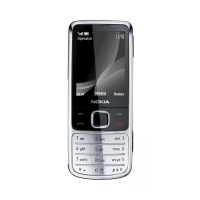•
Turn the wireless device off if there is any r
eason to suspect that interference
is taking place.
•
Follow the manufacturer directions for the
implanted medical device.
If you have any questions about using yo
ur wireless device with an implanted
medical device, consult your health
care provider.
Hearing aids
Some digital wireless devices may inter
fere with some hearing aids.
Vehicles
RF signals may affect improperly installed
or inadequately shielded electronic
systems in motor vehicles such as elec
tronic fuel injection, electronic antilock
braking, electronic speed control, and
air bag systems. For more information, check
with the manufacturer of your vehicle or
its equipment.
Only qualified personnel should servic
e the device or install the device in a vehi
cle.
Faulty installation or service may be d
angerous and may invalidate your warranty.
Check regularly that all wireless devi
ce equipment in your vehicle is mounted
and
operating properly. Do not store or carr
y flammable liquids, gases, or explosive
materials in the same compartment as
the device, its parts, or accessories.
Remember that air bags inflate with g
reat force. Do not place your device or
accessories in the air bag deployment are
a.
Switch off your device before boarding
an aircraft. The use of wireless teledevices
in an aircraft may be dangerous to th
e operation of the aircraft and may be ill
egal.
Potentially explosive environments
Switch off your device in any area with
a potentially explosive atmosphere. Obey
all
posted instructions. Sparks in such areas
could cause an explosion or fire resulting
in bodily injury or death. Switch off the d
evice at refuelling points such as near gas
pumps at service stations. Observe rest
rictions in fuel depots, storage, and
distribution areas; chemical plants; or
where blasting operations are in progres
s.
Areas with a potentially explosive at
mosphere are often, but not always, clearl
y
marked. They include areas where you woul
d be advised to turn off your vehicle
engine, below deck on boats, chemical
transfer or storage facilities and where th
e
air contains chemicals or particles suc
h as grain, dust, or metal powders. You sho
uld
check with the manufacturers of vehicl
es using liquefied petroleum gas (such as
propane or butane) to determine
if this devi
ce can be safely used in their vicinity.
Emergency calls
Important:
This device operates using radio signal
s, wireless networks, landline
networks, and user-programmed functi
ons.
The device will attempt to make
emergency calls only over cellular networ
ks. Connections in al
l conditions cannot be
guaranteed. You should never rely sol
ely on any wireless device for essential
communications like medical emergencie
s.
To make an emergency call:
1 If the device is not on, switch
it on. Check for adequate signal strength
.
Depending on your device, you may al
so need to complete the following:
•
Insert a SIM card if your device uses o
ne
•
Remove certain call restrictions you ha
ve activated in your device.
•
Change your profile from offline or fl
ight profile mode to an active
profile.
2 Press the end key as many tim
es as needed to clear the display and rea
dy the
device for calls.
3 Enter the official emergency nu
mber for your present location. Emergency
numbers vary by location.
4Press the call key.
When making an emergency call, gi
ve all the necessary information as accurate
ly as
possible. Your wireless device may b
e the only means of communication at the
scene
of an accident. Do not end the call
until given permission to do so.
Certification information (SAR)
This mobile device meets guidelines
for exposure to radio waves.
Your mobile device is a radio transmi
tter and receiver. It is designed not to ex
ceed
the limits for exposure to radio wa
ves recommended by international guide
lines.
These guidelines were developed by the in
dependent scientific organisation ICNIRP
60 Product and safety information
Cyan

